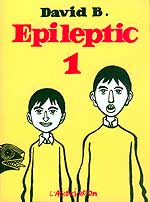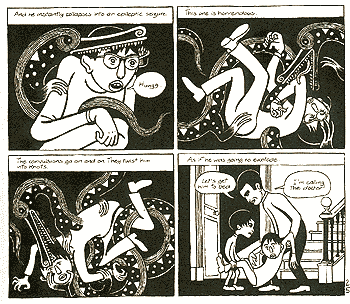
|
First published in France, "Epileptic" will appear in English as a two-volume set. Volume one comes out this month, with volume two tentatively set for late 2003. Though it may seem indulgent to put the life story of a not-very-famous cartoonist into two big books, in fact it matches the epic sweep of David B.'s ambitious approach. Combining both world and personal history, the center remains the author's older brother, Jean-Christofe, who begins having epileptic seizures at age seven. Living in France during the late 1960s, the Beauchards first try Western medicine but balk at the prospect of dangerous brain surgery. Instead they began exploring alternatives like Macrobiotics, an Asian-based system of diet and spirituality. These efforts result in short-lived successes, with the Beauchards leading increasingly isolated lives and Jean-Christofe sinking deeper into anger and illness. By the end of book one the author's parents are "lost" amid the many dead-end, hocus-pocus cures, Florence the younger sister has attempted suicide, and the author has locked himself inside the armor of a twelve-year-old cynic.
As a child the author mitigated his rage through the constant drawing of carnage-filled battle scenes. This precocious interest in history and artistic expression now informs his work with greater insight, but no less passion. The book frequently digresses from Jean-Christofe's pathology into narratives of the Beauchard family history. World War I and French Indochina scar the men, while the women are desperate for education to get off the farm. Their struggles mirror the Beauchard's battle with disease. When the author's great-grandmother practices "white magic" and tells his mother of the fairies living in the fields, you can see where the door opened for his mother's eventual absorption in ouija and spiritualism. At once the story of a family in crisis, a snapshot of the late-1960s, the diary of an artist in the making, and a meditation on how the past informs the present, "Epileptic" interweaves them all into a remarkable literary whole.
 Jean-Christofe's demon twists him into knots
Jean-Christofe's demon twists him into knots |
On top of that, you get pictures. The black and white illustrations of "Epileptic" have a simple, cartoonish line without any cross-hatch shading. Instead, David B. puts the visual richness into mixing the literal with the metaphorical. Anything goes with comix. It's partly what makes them special. Freed from literal representation, the artist's only obligation is to meaning and David B. takes full advantage of this. People grow and shrink, or occasionally appear as animals. Backgrounds become patterns that reflect the mood of the scene rather than the location. One remarkable panel shows Jean-Christofe's head surrounded by a knot of tubes and two tiny doctors plugging them into his skull. Demons, monsters and ghosts become an integral part of the narrative. Jean-Christofe often has a snake-like creature running around and through his body which twists him up in its coils during his fits. Towards the end, in a fantastic convergence of reality and metaphor, these ghosts become real to the author's mother, who feels haunted by her late father.
David B.'s "Epileptic" rivals Art Spiegelman's "Maus," for it's tour de force of comix-making. Though "Epileptic" lacks the heightened drama of the holocaust, these two-volume works have many noticeable parallels. Both use the plight of a stricken family member to fuel a story that goes back and forth in time, examining the repercussions on the author. Both have a deeply-informed sense of personal history within the context of world events and culture, making sense of the relationship between the two. Lastly, both use the medium of comics to further the meaning of the work, creating a unique and lasting contribution to the art form and to art.
"Epileptic" will be available in comic and regular bookstores alike
